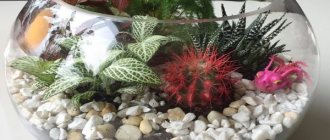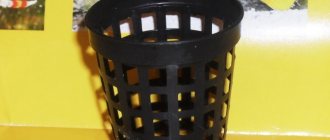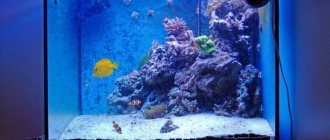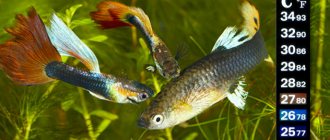To decorate an aquarium, many people choose beautiful plants that add pleasant liveliness to the water element. They act not only as an attractive decoration, but also provide great benefits for fish and other inhabitants of the home pond.
In the article we will tell you why you need live plants in an aquarium, the main advantages and possible difficulties, we will list the best unpretentious aquarium plants for beginners, how to plant them, how to arrange them correctly, what is needed for growth, and features of caring for plants in an aquarium.
About the benefits of live plants in an aquarium
In the care of aquarium fish, living plants play a huge role, creating the correct microflora. They purify water, absorb carbon dioxide and organic matter released by the inhabitants of the reservoir in the process of life. A particular benefit of live vegetation in aquariums is the saturation of water with oxygen, and for some fish, live plants become additional food.
In addition, the flora in the aquarium performs an aesthetic function and has a beneficial effect on the condition of the fish. In the green thickets, the inhabitants of the aquarium can hide, rest, relieve stress and spawn. The young fish live among the vegetation until they become stronger. And in general, an aquarium without living plants looks empty and dull.
Ferns
It is not for nothing that ferns are considered one of the most beautiful plants for artificial aquarium design. They can provide both a wonderful shelter for the inhabitants of a decorative tank and an additional source of oxygen for them.
Among the most popular are azolla carolina, bolbitis, lomariopsis, marsilia crenata.
Fern-like plants are unpretentious in care and take root well in an artificial reservoir.
How much should I plant?
The number of seedlings for an aquarium is calculated taking into account the volume of the tank and the number of living fish. The more of them there are in the aquarium, the higher the need for oxygen and vegetation. But it is also unacceptable to overdo the number of plants, since they can harm the fish and occupy the entire free territory of the aquatic environment, preventing the inhabitants of the home pond from swimming normally.
According to experts, for an aquarium 40 cm wide and 100 cm long, the maximum number will be 80 plants. The degree of growth of the selected plant species and its height are also taken into account. Plants that are too tall cannot be planted in small, low aquariums where fish are kept.
We choose based on the conditions
Before you start selecting vegetation for your pond, you need to find out what conditions are created in it. First of all, the amount of light is measured. To do this, take the power of the lamps in watts (if there are several of them, then the sum of the powers) and divide it by the volume of water. For example, in a standard 80-liter aquarium there are 2 fluorescent lamps of 18 W each, which means the illumination will be 0.45 W per liter. It is quite enough for undemanding species, if the lamps are new, the spectrum is selected correctly, and the height of the aquarium does not exceed 40-45 cm. For incandescent lamps, the power should be approximately three times higher, and for LEDs - less, but lamps of these types are used less often in aquarium farming and for beginners are not recommended.
Next, you need to evaluate the values of acidity and hardness; this can only be done using special tests. They are now available in many pet stores in large cities and are not particularly expensive. Residents of small towns and villages, where such delights cannot be found, can be recommended to order them in online stores or ask experienced aquarists to use them, having met them on the forum.
aquarium plants
It should be noted that most plants do not like hard water (with a total hardness gH above 8° and temporary carbonate hardness kH above 6°). If your tap water exceeds this indicator, then you need to either select the appropriate types of plants (and there are not many of them), or reduce the hardness - this is done by adding reverse osmosis or distilled water. If it is not possible to get it, then use boiled water without sediment. Another option: check the hardness values of different types of bottled water and try to find a soft one among them.
Based on the results obtained, the selection of plants begins.
Main types of aquarium plants
Aquarium living plants are classified into several groups according to the characteristics of their habitat in water.
Plant types:
- growing on the bottom of the aquarium (bryophytes, spring, hypnaceae, etc.);
- freely floating in the water column or on its surface (hornworts, duckweeds, bladderworts, etc.);
- growing in the ground, but forming flowers and leaves floating on the surface of the water (water lilies, aponogetonaceae);
- freely floating on the water surface (pontederiaceae, watercranes, etc.);
- growing at the bottom and blooming under water (naiads, zanikeliaceae);
- growing at the bottom and bringing flower stems to the surface of the water (urut, water buttercups, etc.);
- rising above the surface of the water (swamp and coastal plants - sedges, aroids, etc.).
Light
Expensive and good is better than bad and cheap. Anyone who says otherwise is probably just joking. It is best to use special lamps for herbal aquariums. But almost any lamp will be suitable for starting our exercises; replacing it with something more serious will happen later. Or it won't happen. A very important device in my opinion is the on and off timer. It is very inexpensive, but it perfectly evens out the daily cycles in the aquarium. There is no need to shine for a long time; for most species, 9 hours is enough. It should be remembered that it is excessively long, and not excessively bright, daylight hours that are one of the main reasons for the appearance of green algae.
Unpretentious plants for the aquarium
Every aquarium plant needs care. However, there are many types of aquatic flora characterized by rapid growth and unpretentiousness.
There is quite a wide choice in this group:
- Vallisneria is a fast-growing plant;
- Cladophora – thread-like green algae;
- duckweed is a fast-growing plant, suitable for all inhabitants of the aquarium;
- hornwort with closely intertwined stems;
- Guadalupe naiad - grows as a small bush;
- hygrophila - a plant with large leaves, looks good in the background;
- elodea - grows quickly, well suited for viviparous fish;
- rapidly multiplying nayas, forming dense green algae;
- Indian fern – small green leaves, can be planted in the ground and used as a floating plant;
- Amazonian Echinodorus - forms spreading bushes with wide oval leaves;
- Java moss is a slow-growing plant that loves good lighting;
- floating riccia - forms dense dense thickets.
Decorative purpose
Depending on what place the vegetation will occupy in the aquarium, it is divided into the following types:
- foreground, represented by anubias, water buttercup, bucephalandra, marsilia, blixa, glossostigma, mosses, etc.
Here, as a rule, there are small but unusual and bright plants that immediately attract attention.
- Medium shot. These include cryptocoryne, cabomba carolina, anubias, ludwigia, rotala, echinodorus.
Plants placed in the center should be higher than the “foreground” plants, but not higher than the plants, using theatrical terminology, the backdrop.
- Tall representatives of the flora with a long stem form the background: alternanthera, aponogeton, bacopa, hornwort.
Best Live Plants for Beginners
To ensure that living plants do not die in the aquarium environment, they must be properly cared for. For those who have decided to start breeding fish with vegetation in a tank for the first time, we recommend choosing plant species that do not require special care for planting.
The best plants for beginner aquarists:
- Related Cryptocoryne - has beautiful leaf color. Grows in any water conditions.
- Cabomba is an undemanding and unpretentious plant, which is a lush green bush with fleshy stems.
- Nomaphyla straight - grows as a dense bush. It is distinguished by its aesthetic appeal and is undemanding in care.
- Cirrus is a beautiful plant that quickly forms dense openwork thickets.
- Key moss is an absolutely undemanding plant in terms of temperature and lighting.
- Thailand fern - grows well even in poor light. Forms spectacular dense thickets.
- Wing fern is an unpretentious species and grows well in a floating state, but there is one important need - bright lighting.
Even simple and unpretentious plant species can beautifully decorate an aquarium and create favorable microflora for the life of fish.
Ferns and mosses
Ferns and mosses are quite popular types of aquarium plants that do not form inflorescences and a full-fledged root system. However, they look attractive in an aquatic environment and require virtually no maintenance.
Types of aquarium ferns and mosses:
- bolbitis;
- Azolla;
- star moss;
- pearl moss;
- prickly moss;
- callicostella;
- lomariopsis;
- Malayan fern;
- moss Cameroon;
- carpet moss;
- Ricardia moss;
- nano-moss;
- orange fern;
- Trident fern;
- angustifolia fern;
- Riccia floating;
- salvinia;
- phylonotis;
- Fern Thor's Hammer.
Rosettes
Plants of the rosette group have one common feature - there is no pronounced stem, and the leaves grow from a single center called the rosette.
Popular rosette plants for the aquarium:
- Anubias;
- aponogeton;
- baldellia;
- blixa;
- small swamp;
- Willisneria;
- watercolor;
- water orchid;
- water cabbage;
- crinum wavy;
- cryptocoryne;
- water lily;
- leleopsis;
- water ranunculus;
- nymphea;
- duckweed;
- teloresis;
- chelantium;
- Eleocharis.
Stem
Stem plants decorate the aquarium and create a favorable environment for the inhabitants of the artificial pond. Not all plants from this category are characterized by unpretentiousness. Some types of stem flora are quite capricious to care for.
Types of stem plants for aquariums:
- Avran officinalis;
- Aldrovanda vesica;
- alternanthera;
- Ammania gracilis;
- aciotis;
- bacopa;
- blixa;
- Bucephalandra;
- water yarrow;
- hygrophila;
- gratiola;
- Amano pearl grass;
- limnophila;
- ludwigia;
- Murdannia;
- naiad;
- ophiopogon;
- pinnate;
- persicaria;
- pogostemon;
- hornwort;
- rotala;
- staurogyne;
- fineness;
- cyanotis;
- elodea;
- Egeria.
Landing rules
Planting in aquarium soil follows special rules.
How to plant aquarium plants correctly:
- Before planting, plants that were previously in an aquatic environment are cleared of snail eggs and algae. Damaged areas are removed from the branches.
- The plant is disinfected with a light pink solution of potassium permanganate and washed with a solution of hydrogen peroxide and water in a ratio of 1 tsp. for 1 liter of water. After disinfection, the plants should be rinsed well in clean water.
- To speed up the growth of the plant, you can trim the roots a little.
- The bottom of the aquarium is filled with washed soil to a depth of about 10 cm and filled with water to a level of 5-10 cm.
- Plants should be planted in the aquarium one at a time, starting from the back wall of the tank.
- The viewing side is left free or small plants are planted that will not block the main space of the aquatic environment.
- A hole is prepared in the soil of the aquarium several centimeters longer than the length of the plant’s root system.
- The roots descend vertically into the ground. They should be located straight in the ground, and not bend in different directions.
- The hole is filled with soil, after which the soil around the plant needs to be crushed a little.
- Gently pull the plant up with your hand so that the neck of the root system appears from the soil.
- Aquatic plants floating in the water column are planted by cuttings without roots. Before planting, the leaves are removed from the two lower stems. Until the plant takes root in the soil, it must be kept from floating to the surface. Small flat stones that hold the plant at the bottom can help with this.
How to properly place plants in an aquarium
To beautifully decorate the water space, you need to properly place the plants inside the tank.
Rules for placing aquarium plants:
- Larger plants are planted against the back wall.
- Small types of vegetation look good on the sides and front wall of the tank.
- Tall plants can be planted along the edges. They are also placed in single copies in the center of the aquarium.
- Light-loving species are placed under the lighting fixtures.
- Creeping plants are planted in the aquarium in groups of 4-6 pieces. The distance between the bushes is 1-2 cm.
- Floating plants can simply be placed in water.
When planting plants in an aquarium, you need to adhere to the principle of their compatibility. Some species of aquarium flora do not survive in close proximity to other representatives. Plant plants of the same species in groups at a distance from other species.
What is needed for active growth
For the active growth of aquatic plants, special fertilizers intended for aquarium flora are used. It is unacceptable to use types of fertilizers for plants in pots.
Pet stores sell different types of fertilizers for aquatic plants. These are tablets and various liquid solutions containing macro- and microelements. Nutrients strengthen roots, improve survival rate after planting, and stimulate active growth and flowering.
In addition to ready-made fertilizers, when planting plants, you can use folk remedies that have been proven over the years. Clay placed in lumps under the root system of the seedling has a good effect on the flora of the aquarium.
Caring for aquarium vegetation
As necessary, the owner will have to carry out some procedures to care for the vegetation in the aquarium.
What the rules of care include:
- pruning overgrowing plants;
- removing rotten leaves;
- pruning daughter branches;
- You need to change the water in the aquarium to clean water weekly;
- Monitor the lighting level and water temperature in the aquarium daily, taking into account the needs of the plant and fish.
Caring for aquatic plants is not as difficult as it seems at first glance. A little patience and studying useful information will help a novice aquarist create all the necessary conditions for the growth of plants and the existence of fish living in a home pond. A beautifully decorated aquarium with aquatic flora and live fish will become a harmonious decoration of the interior, causing admiration and delight among guests at home.
Advantages and disadvantages of using artificial analogues
In some cases, the use of artificial synthetic substitutes in aquariums is not only justified, but also necessary. Artificial plants are needed for aquariums with African cichlids and large herbivorous fish - distichodes, leporines, catfish, for which greens are important as feeding.
Artificial plants in the aquarium
Artificial plasses and “amazons” look quite natural, especially in combination with mosses, stones and driftwood.
Advantages of artificial vegetation compared to natural ones:
- do not grow;
- do not require feeding;
- don't get sick.
However, as we wrote earlier, it is impossible to equip an aquarium only with artificial plants - the necessary biological balance will not be achieved, which can lead to the death of the fish. It is best to find an acceptable decorative balance between living and synthetic.











